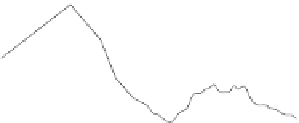Geoscience Reference
In-Depth Information
2.4. VERTICAL SPECTRA
Using the same digital acceleration database, vertical components have been also
analysed in terms of the median
V
(
T
)/
H
(
T
)
response spectral ratios. In this section,
V
is the
geometric average of the response spectral ordinates of the horizontal components at
period
T
.
(
T
)
is intended as the 5% damped
DRS
of the vertical component, while
H
(
T
)
A summary of results is plotted in Figure 2.6, for magnitude ranges from 5 to 6.6; the
median
V
/
H
ranges typicallyfrom0.4to0.7,withavariation with
T
weakly dependent
on magnitude and distance, except for higher magnitudes and small distances, where the
ratio tends to increase, but does not exceed 0.9.
Compared in Figure 2.7 are the present results for 6
.
0
≤
M
≤
6
.
3 and 10km
≤
R
≤
30km,includingthe16-and84-percentilecurvesbesidesthemedianone,withthe
V
H
ratios deduced from a few widely used attenuation relationships. Except for Ambraseys
and Simpson (1996), exceeding the 84-percentile in a narrow range at short periods, the
other ratios lie within the variability range of our data. Note, incidentally, that the ver-
tical design spectra implemented in CEN (2004) are essentially based on the results of
Ambraseys and Simpson (1996) that, based on this study, appear to be overconservative
for
T
/
<
0
.
2s.
1
1
5.0
<=
M<
=
5.4
5.5
<=
M
<=
5.9
0.8
0.8
0.6
0.6
0.4
0.4
0.2
0.2
0
1
0
1
6.0
<=
M
<=
6.3
6.4
<=
M
<=
6.6
0.8
0.8
0.6
0.6
0.4
0.4
0.2
0.2
0
10
−
2
0
10
−
1
10
0
10
1
10
−
2
10
−
1
10
0
10
1
Period (s)
Period (s)
H
for different magnitude and distance
range: 10-30km (thin solidlines), 30-50km (dashed lines), 50-75km (dotted lines),
75-100km (thick solidlines)
Fig. 2.6. Median response spectral ratios
V
/










